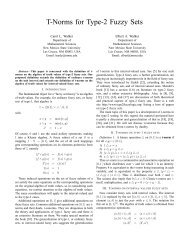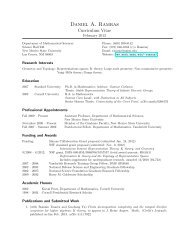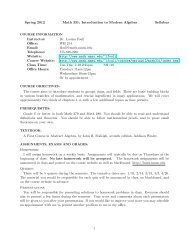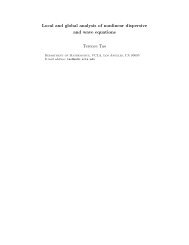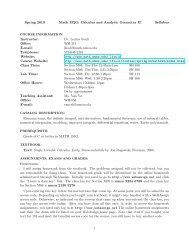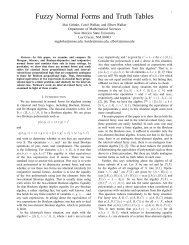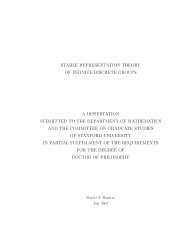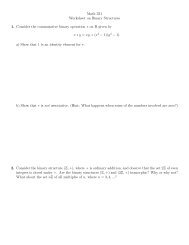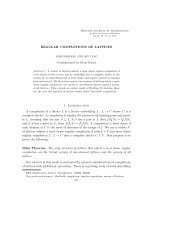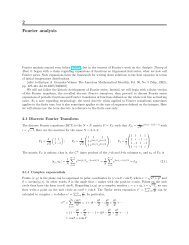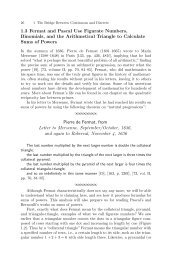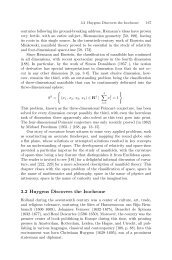[a n ; b n ] subintervals of [R; L], with a 1 = b 1 = R, <strong>an</strong>da n = b n = L.)3) Find the intersection of all distinct pairs of intervals <strong>from</strong>[a i ; b i ], i = 2; 3; :::; n 1, such that these intersectionsare proper closed intervals; that is, are of the form [a; b]with a < b. Let I be the set of these intersectionstogether with all the proper intervals [a i ; b i ]: (The intersectionof <strong>an</strong>y nonempty family S of the intervals[a i ; b i ] is either a member of S or c<strong>an</strong> be obtained asthe intersection of two members of S.)4) For each interval I 2 I, form the family S I of allintervals [a i ; b i ] containing I, so for each intersection[a; b], S [a;b] is the family of all the intervals in f[a i ; b i ] :i = 2; 3; :::; n 1g containing [a; b]. Note that S [a;b] hasa multiplicity, namely the number of (not necessarilydistinct) intervals containing [a; b]:5) For those intervals [a i ; b i ] not in S I <strong>an</strong>d such that a i 0:268 082 > 1 n = 0:25:There are no more intervals to check, so the minimumis H (x) = 0:268 082, which occurs for x =(0:33; 0:648 305; 0:69; 0:75).From the two preceding examples, it is easy to see whathappens for <strong>an</strong>y family of mutually disjoint intervals: for each
proper interval [a i ; b i ], choose all the right endpoints to theleft of the interval <strong>an</strong>d all the left endpoints to the right of theinterval. Use the point in [a i ; b i ] determined by Lemma 7 <strong>an</strong>dcompute the resulting H (x). Then compare these <strong>an</strong>d nd theminimum.In the case the intervals are not all mutually disjoint, thesituation is a bit more complicated <strong>an</strong>d the more subtle pointsin the algorithm come into play. The next example is moreillustrative of the algorithm.Example 10: Consider the seven intervalsJ 1 = [0:2; 0:3]J 2 = [0:35; 0:5]J 3 = [0:15; 0:375]J 4 = [0:1; 0:3]J 5 = [0:35; 0:7]J 6 = [0:25; 0:5]J 7 = [0:4; 0:8]1) The intersection of the intervals is empty.2) R = 0:3 <strong>an</strong>d L = 0:4: Replacing [a i ; b i ] by [a i _ R; b i ^L] yields the intervalsI 1 = [0:3; 0:3]I 2 = [0:35; 0:4]I 3 = [0:3; 0:375]I 4 = [0:3; 0:3]I 5 = [0:35; 0:4]I 6 = [0:3; 0:4]I 7 = [0:4; 0:4]3) We get the new interval I 8 = [0:35; 0:375], <strong>an</strong>d I =fI 2 ; I 3 ; I 6 ; I 8 g. (I 2 = I 5 ; so we need not list I 5 :)4) For each interval I 2 I, forming the family S I of allintervals containing I yieldsa) S I2 = fI 2 ; I 5 ; I 6 gb) S I3 = fI 3 ; I 6 gc) S I6 = fI 6 gd) S I8 = fI 2 ; I 3 ; I 5 ; I 6 g5) For each of these four families there happens to be onlyone choice for endpoints for each of the intervals not inS I .a) S I2 = fI 2 ; I 5 ; I 6 g pairs with P I2 = fP 1 = 0:3,P 3 = 0:375, P 4 = 0:3, P 7 = 0:4gb) S I3 = fI 3 ; I 6 g pairs with P I3 = fP 1 = 0:3, P 2 =0:35, P 4 = 0:3, P 5 = 0:35, P 7 = 0:4gc) S I6 = fI 6 g pairs with P I6 = fP 1 = 0:3, P 2 =0:35, P 3 = 0:375, P 4 = 0:3, P 5 = 0:35, P 7 =0:4g. But by Lemma 4, the endpoints P 2 <strong>an</strong>d P 3c<strong>an</strong>not both be part of a solution, so we discardthis option.d) S I8 = fI 2 ; I 3 ; I 5 ; I 6 g pairs with P I8 = fP 1 = 0:3,P 4 = 0:3, P 7 = 0:4g6) For each of these three remaining options S I2 , S I3 ; <strong>an</strong>dS I8 we compute the valuesf I (x) = k I xS I 2+ Xx j2P IxjS I 2where k I is the number of intervals in S I , S I =k I x + P x j2P Ix j , <strong>an</strong>d x is either <strong>an</strong> endpoint of theintersection of S I that lies in the interior of [R; L], orP nxx = i2P Ix 2 iP n :x i2P Ix ia) For S I2 = fI 2 ; I 5 ; I 6 g we have I 2 = [0:35; 0:4]<strong>an</strong>d P I2 = f0:3; 0:375; 0:3; 0:4g. Thenx = 0:32 + 0:375 2 + 0:3 2 + 0:4 20:3 + 0:375 + 0:3 + 0:4= 0:349 55 =2 [0:35; 0:4]By Lemma 7, since 0:349 55 < 0:35; on I 2 =[0:35; 0:4] ; the minimum is assumed at 0:35: Wehave3 (0:35) + 0:3 + 0:375 + 0:4 = 2: 125<strong>an</strong>d so the value of H for this set of points is 2 20:35 0:3f I2 (0:35) = 3 +2: 125 2: 125 2 20:375 0:4++2: 125 2: 125= 0:167 89b) For S I3 = fI 3 ; I 6 g, we have I 3 \ I 6 = [0:3; 0:375]<strong>an</strong>d P I3 = f0:3; 0:35; 0:3; 0:35; 0:4g, <strong>an</strong>dx = 0:32 + 0:35 2 + 0:3 2 + 0:35 2 + 0:4 20:3 + 0:35 + 0:3 + 0:35 + 0:4= 0:344 12 2 [0:3; 0:375]By Lemma 7, since 0:344 12 2 [0:3; 0:375] ;on [0:3; 0:375] ; the minimum is assumed at0:344 12:which has multiplicity 2: We have2 (0:344 12)+0:3+0:35+0:3+0:35+0:4 = 2: 388 2<strong>an</strong>d so the value of H for this set of points is 2 0:344 12 0:3f I3 (0:344 12) = 2+2: 388 2 2: 388 2 2 0:35 0:3++2: 388 2 2: 388 2 2 0:35 0:4++2: 388 2 2: 388 2= 0:144 09 2 2d. For S I8 = fI 2 ; I 3 ; I 5 ; I 6 g we have I 2 \I 3 \I 4 \I 6 =[0:35; 0:375] <strong>an</strong>d P I8 = f0:3; 0:3; 0:4g ; <strong>an</strong>dx = 0:32 + 0:3 2 + 0:4 20:3 + 0:3 + 0:4= 0:34 =2 [0:35; 0:375] 2



